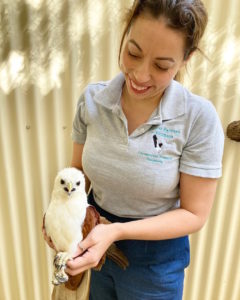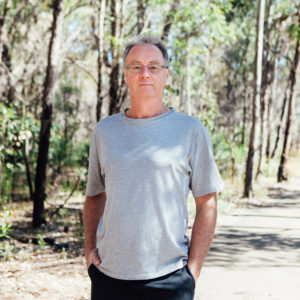Griffith University has joined forces with the Currumbin Wildlife Hospital Foundation (CWHF) to track the movements of coastal birds of prey after rehabilitation.
While the CWH has proven techniques for bringing injured for birds of prey like sea-eagles, kites and osprey back to health, their success after release remains largely unknown.

Vicky Thomson, PhD candidate and founder of Coastal Raptors of Australia
Professor Darryl Jones, Deputy Director of the Environmental Futures Research Centre and Vicky Thomson, PhD candidate and founder of Coastal Raptors of Australia are collaborating with the CWH to fill this knowledge gap and find out how well these bird species can readapt and survive in the environment after rehabilitation.
“Rehabilitation can often take months and cost thousands of dollars per bird, with major surgeries often required,” Ms Thomson said.
“It is very expensive and time consuming, and previously we didn’t know whether or not these efforts were actually working or indeed suitable for these large birds.”
To determine the success of current rehabilitation efforts for coastal raptors at CWH, the researchers are following detailed movements of the birds after release with GPS tracking and are using leg banding as a cost effective way to discover if birds are being reinjured and readmitted to the wildlife hospital.
“So far, we have banded 22 coastal raptors and have successfully GPS-tracked two white-bellied sea-eagles,” Ms Thomson said.
“It’s exciting work. This is the first study to track the success of rehabilitated raptors at CWHF, and to extensively GPS track white-bellied sea-eagles post-rehabilitation and release beyond a few weeks.”
“Having tracked the two white-bellied sea-eagles for five and seven months, we were able to show that the rehabilitation efforts work. Far from having to come back to the hospital and humans for food, these birds when released, are able to survive and in fact thrive on their own.”
Yet as Professor Jones noted, it’s not all smooth sailing for rehabilitated birds of prey as they still face a host of human threats.

Professor Darryl Jones – urban ecologist.
“Unfortunately one of the sea-eagles was killed in an illegally set drift net. The whereabouts of the other remains unknown after device failure, but she was doing well before we lost signal from the GPS.”
“The birds that we have put bands on can give us information in a number of ways. The condition of any banded birds re-admitted to the hospital and the length of time after release will tell us whether or not they’re coping in the wild.
“Perhaps surprisingly, photographing the banded coastal raptors at close range can actually lead to their identification, without them having to be recapture. For example, an Osprey we named Pippin was photographed by the Tweed Osprey Group and reported it to us for identification. This is an exciting development as he bred this season and the Tweed Osprey Group is actively monitoring his progress.”
To help ensure the wildlife hospital’s raptor recovery program and this successful collaboration can continue into the future, the Griffith research team has made a donation $1000 to the CWHF.
